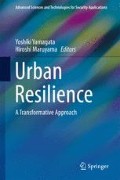Abstract
Many complex systems can be modeled as a graph consisting of nodes and connecting edges. Such a graph-based model is useful to study the resilience of decentralized systems that handle a system failure by isolating a subsystem with failed components. In this chapter, we study a graph clustering problem for electrical grids where a given grid is partitioned into multiple microgrids that are self-contained in terms of electricity balance. Our goal is to find an optimal partition that minimizes the cost of constructing a set of self-sufficient microgrids. To obtain a better solution accommodating smaller microgrids, we develop an efficient verification algorithm that determines whether microgrids can balance their electricity surplus through electricity exchange among them. Our experimental results with a dataset about Yokohama city in Japan show that our proposed method can effectively reduce the construction cost of decentralized microgrids.
Access this chapter
Tax calculation will be finalised at checkout
Purchases are for personal use only
Notes
References
Aarts, E., & Korst, J. (1988). Simulated annealing and Boltzmann machines: A stochastic approach to combinatorial optimization and neural computing. New York: Wiley.
Arizumi, N., Minami, K., Tanjo, T., Maruyama, H., Murakami, D., & Yamagata, Y. (2014). A first step towards resilient graph partitioning for electrical grids. In Proceedings of the 7th International Conference on Information and Automation for Sustainability (ICIAfS) (pp. 1–6). IEEE. doi:10.1109/ICIAFS.2014.7069608
Berger, M. J., & Bokhari, S. H. (1987). A partitioning strategy for nonuniform problems on multiprocessors. IEEE Transactions on Computers, 100, 570–580.
Bui, T. N., & Jones, C. (1993). A heuristic for reducing fill-in in sparse matrix factorization. In Proceedings of the 6th SIAM Conference on Parallel Processing for Scientific Computing (pp. 445–452).
Edmonds, J., & Karp, R. M. (1972). Theoretical improvements in algorithmic efficiency for network flow problems. Journal of the ACM, 19(2), 248–264. doi:10.1145/321694.321699, url:http://doi.acm.org/10.1145/321694.321699
Geng, Y., & Cassandras, C. G. (2011). Dynamic resource allocation in urban settings: A smart parking approach. In 2011 IEEE International Symposium on Computer-Aided Control System Design (CACSD) (pp. 1–6). doi:10.1109/CACSD.2011.6044566
Hendrickson, B., & Leland, R. (1993). Multidimensional spectral load balancing. Technical report, Sandia National Labs., Albuquerque, NM, USA.
Itagaki, A., Okamura, H., & Yamada, M. (2003). Preparation of meteorological data set throughout japan for suitable design of PV systems. In Proceedings of the 3rd World Conference on Photovoltaic Energy Conversion (pp. 2074–2077).
Karypis, G., & Kumar, V. (1995). Metis-unstructured graph partitioning and sparse matrix ordering system, version 2.0. Technical report.
Kyriakidis, P. C. (2004). A geostatistical framework for area-to-point spatial interpolation. Geographical Analysis, 36(3), 259–289.
Minami, K., Tanjo, T., Arizumi, N., & Maruyama, H. (2014). Flexible graph partitioning of power grids with peer-to-peer electricity exchange. In Proceedings of the 7th International Conference on Information and Automation for Sustainability (ICIAfS) (pp. 1–6). IEEE. doi:10.1109/ICIAFS.2014.7069631
Shahrokhi, F., & Matula, D. W. (1990). The maximum concurrent flow problem. Journal of the ACM, 37(2), 318–334. doi:10.1145/77600.77620, url:http://doi.acm.org/10.1145/77600.77620
Van Laarhoven, P. J., & Aarts, E. H. (1987). Simulated annealing: Theory and application. Heidelberg: Springer.
Yamagata, Y., Murakamia, D., Minami, K., Arizumi, N., Kuroda, S., Tanjo, T., et al. (2015). Comparative study of clustering algorithms for electricity self-sufficient community extraction. In Proceedings of the 7th International Conference on Applied Energy. IEEE.
Yamagata, Y., & Seya, H. (2012). Integrated modelling for a future smart city: Toward efficient CO2 management of EV transport using PV systems. In Proceedings of the 19th ITS World Conference (pp. 2–26).
Yamagata, Y., & Seya, H. (2013). Community-based resilient electricity sharing: Optimal spatial clustering. In Proceedings of the 43rd Annual IEEE/IFIP Conference on Dependable Systems and Networks Workshop (DSN-W) (pp. 1–8). doi:10.1109/DSNW.2013.6615539
Yamagata, Y., & Seya, H. (2014). Proposal for a local electricity-sharing system: A case study of Yokohama city. Japan: IET Intelligent Transport System.
Yamagata, Y., Seya, H., & Kuroda, S. (2014). Smart community clustering for sharing local green energy. In Proceedings of the 2014 International Conference and Utility Exhibition on Green Energy for Sustainable Development (ICUE) (pp. 1–7).
Yokoi, T., Yamamoto, Y., Tokai, A., & Morioka, T. (2010). Development of decision support system to integrate block renewal and energy planning towards low-carbon city. JSCE, 66(1), 17–34 (in japanese).
Author information
Authors and Affiliations
Corresponding author
Editor information
Editors and Affiliations
Rights and permissions
Copyright information
© 2016 Springer International Publishing Switzerland
About this chapter
Cite this chapter
Minami, K., Tanjo, T., Arizumi, N., Maruyama, H., Murakami, D., Yamagata, Y. (2016). Resilient Community Clustering: A Graph Theoretical Approach. In: Yamagata, Y., Maruyama, H. (eds) Urban Resilience. Advanced Sciences and Technologies for Security Applications. Springer, Cham. https://doi.org/10.1007/978-3-319-39812-9_7
Download citation
DOI: https://doi.org/10.1007/978-3-319-39812-9_7
Published:
Publisher Name: Springer, Cham
Print ISBN: 978-3-319-39810-5
Online ISBN: 978-3-319-39812-9
eBook Packages: Earth and Environmental ScienceEarth and Environmental Science (R0)

